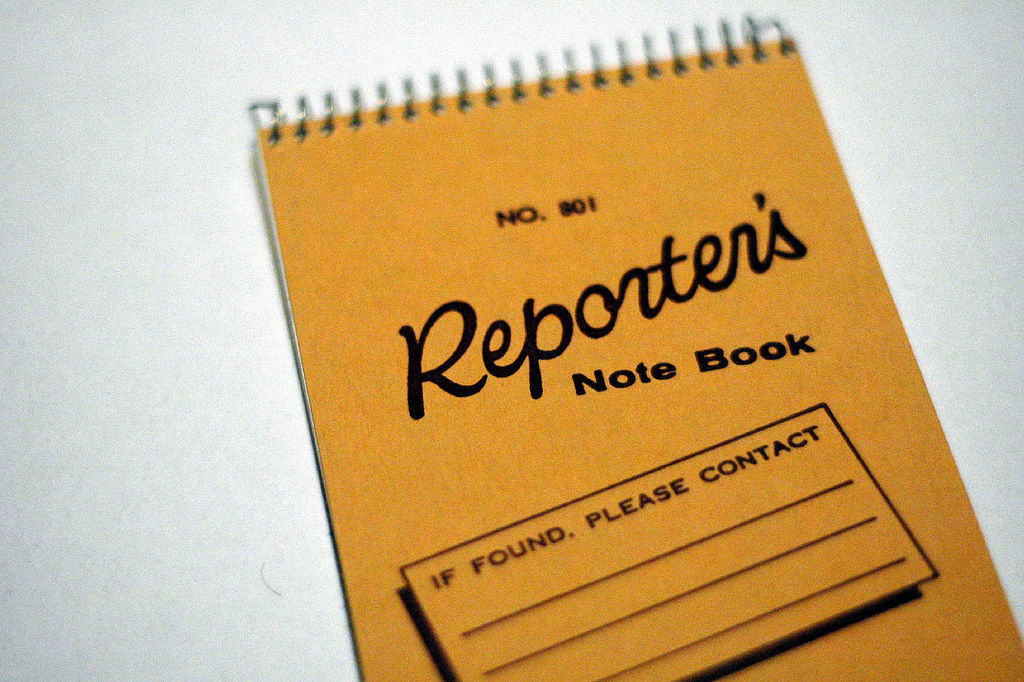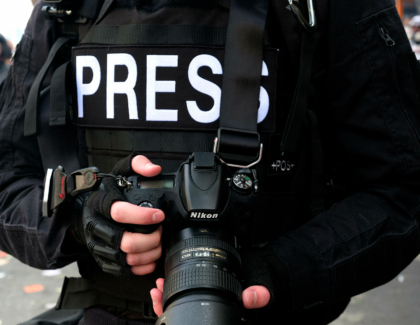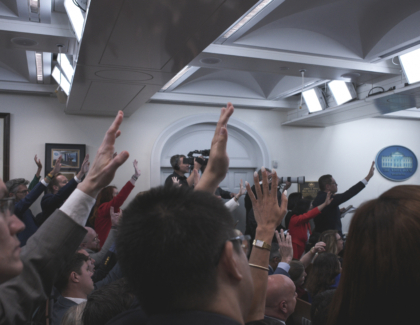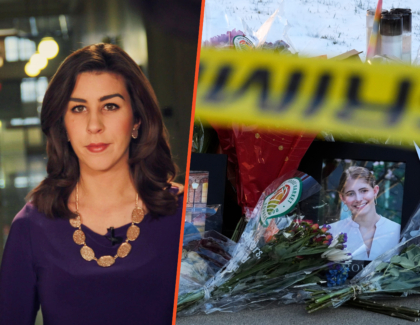Sign up for the daily CJR newsletter.
We’ve all read headlines like this before: “This Student With Cerebral Palsy Went To Prom With Her Best Friend And It Was Magical.” For decades, the media has tended to portray people with disabilities (or those around them) as inspirations or heroes—a genre of reporting known as “inspiration porn.”
There are countless stories about waiters helping to feed patrons with disabilities (and getting a new job for doing so), friends helping disabled people with basic tasks that have nothing to do with their disabilities, and very public “promposals” similar to the one touted in the headline above. Many of these stories go viral.
Most recently, the internet’s collective heart melted over a story about a mother who received an honorary MBA degree after attending classes with her quadriplegic son while he was in business school. According to the story, first reported by The Orange County Register on May 20, Judy O’Connor moved from Florida to southern California to help her son Marty, from taking notes for him in class at Chapman University to writing down his answers for exams. It was at the Chapman graduation ceremony that Judy received the degree—originally her son’s idea.
Three days after The Orange County Register published the article, the Associated Press picked it up, and soon nearly every major news outlet in the United States, from CNN to People magazine, had covered it.
On social media, the response was unanimous. One Twitter user commented, “Cheers to this mother who didn’t let anything stop her!” A Canadian teacher’s association dubbed the story a “feel good moment.”
Such a touching story of a mother's love and devotionhttps://t.co/T5BE8tguKm
— Kinetic Kids (@kinetickidstx) June 2, 2017
Register features writer Keith Sharon first received notice about the O’Connors from a Chapman University representative, and then pitched the idea to fellow reporter Shane Newell because he couldn’t work that weekend. Sharon says he was initially attracted to the story because of its emotion and the surprise element—the fact that Judy O’Connor had no idea she was about to be recognized in public for her hard work and advocacy as a mother.
“As a storyteller, I think the strongest stories are the ones that connect us all,” says Sharon, who’s covered features since the early 1980s. “Not everyone understands what a quadriplegic has to deal with, but everyone understands what a relationship is like with their mother. Everyone understands what the effort is like to graduate from college. Those would be the emotions that I’d really focus on in a story like that.”
Newell agrees, calling it a “universal story” that resonated with people who were reminded of loved ones or who understood the desire to “give back.”
THERE IS NO DOUBT that most of these stories—aimed at restoring faith in humanity— are grounded in good intentions. But this emotion-driven journalism is the hallmark of inspiration porn, which often focuses on the altruism of those who help people with disabilities. Although the term has been around for several years, “inspiration porn” was popularized in a TED talk that the late Australian activist Stella Young gave in April 2014. Her talk now has more than 2.4 million views online.
Of the eight news values (proximity, timeliness, prominence, magnitude, conflict, oddity, impact, and emotion), emotion too often rises to the top when telling stories about disability communities. The story about the mother getting an honorary MBA degree is newsworthy because it tugs at readers’ heartstrings. But inspiration porn rarely goes beyond that to address major disability issues like workplace discrimination, stigma and bullying, and accessibility in schools. Does Chapman provide personal aides for disabled students like Marty O’Connor? How can colleges better promote a more inclusive learning environment for disability communities at large?
Perhaps it’s not that inspirational articles about people with disabilities shouldn’t be written at all. Rather, we should do our best to cover disability communities using the same fundamentals of journalism we would use to cover any other group: Get to know your sources well, consider the many different angles of a single story, and find out how your story can serve readers and subjects alike beyond simply “inspiring” them.
People with disabilities are the largest minority group in the US, where they make up 19 percent of the population, according to the website for the National Center on Disability and Journalism. The center, headquartered at the Walter Cronkite School of Journalism and Mass Communication at Arizona State University, provides resources and guidance for journalists covering the disability beat.
Disability reporting has improved to some degree over the years, says Kristin Gilger, director of the National Center on Disability and Journalism. While terms like “wheelchair-bound” were once rampant, they’re now generally frowned upon in newsrooms. More news outlets are making space for people with disabilities. The New York Times, for instance, publishes an ongoing op-ed series for people to share their personal experiences of living with a disability. Finally, the uncertain future of America’s health care system has called media attention to what repealing the Affordable Care Act would mean for people with disabilities.
But for every well-reported piece of journalism tackling real issues within the disability community, there are many more articles that offer little more than inspiration porn.
THESE “CHARITY STORIES,” as disability journalist David M. Perry calls them, not only perpetuate disability stigma but also objectify people with disabilities by focusing solely on the disability, rather than accepting the source as a multi-faceted human being. As a result, journalists may assume, for instance, that getting a parent or a partner’s quote about a disabled person’s thoughts and feelings is enough—rather than interviewing the person directly.
“Strive to represent what our sources say about them as accurately and clearly as possible,” says Perry, the father of a child with Down syndrome, who has written about disability and parenting for The New York Times, CNN, Al Jazeera, and The Atlantic. “So often, we assume [disabled people] can’t communicate for themselves and report instead on what’s going on around them.”
For every well-reported piece of journalism tackling real issues within the disability community, there are many more articles that offer little more than inspiration porn.
In the case of The Register’s story, before graduation day, Newell says he spoke with the school’s communications director and Marty’s professor, who had approved Marty’s request for his mother to receive the degree. Although he didn’t talk to Marty directly prior to graduation, Newell says pre-interviewing the professor gave him a sense of Judy’s role in her son’s classes and prepared him to cover the story.
After Marty and Judy received their MBA degrees and the graduation ceremony ended, Newell made a beeline for them and did an interview.
“Marty was very adamant that his mom deserved that degree because of the role she had in his education,” Newell says. “At its core, it’s really a story about a son wanting to thank his mother. The generosity and foresight that Marty had in order to do something like this was incredible. His mom definitely played it down. She basically told me that any mother would do this for her son.”
Some news outlets reached out to the O’Connors for additional comment. Reporter Ellina Abovian interviewed both Judy and Marty O’Connor for KTLA, a television station in Los Angeles. In her segment, Abovian reported that Judy had been “living in the shadow” for two years, helping her son “to make sure that his dream could come true” while he was at Chapman—that is, until she was recognized with the surprise honorary degree.
Many outlets that covered the Chapman graduation story wrote their own versions—along with trending headlines—based on The Register’s original story and Chapman University’s website. Newell says the few media outlets that reached out and interviewed the O’Connors had gone “above and beyond.”
Nervous about covering accessibility issues? Check out our 'Tips for interviewing people with disabilities' page. https://t.co/GXaGEFL9hx
— NCDJ (@NCDJ_ASU) August 29, 2017
While Sharon says it’s crucial for reporters to “treat (people with disabilities) like anybody else,” he also believes there is value in stories that portray people with disabilities or their caregivers, friends, and strangers who help them as inspirations.
“I love those [stories] because of the humanity,” he says. “It’s because people are showing each other the best of themselves.”
INSPIRATION PORN may “make people feel good in a not-so-great political climate,” says Emily Ladau, editor in chief of Rooted in Rights, a digital media platform that covers disability rights, and a speaker on disability issues in the media. Stories in which people with disabilities clearly approve of having themselves or people around them portrayed as inspirations are also less likely to be stigmatizing. In the Chapman graduation story, for example, it was Marty O’Connor’s idea to surprise Judy with an honorary degree and lift her up as an inspiring mother.
But journalists should also consider where a story’s newsworthiness comes from and how it contributes to overall disability coverage.
Stories in which people with disabilities clearly approve of having themselves or people around them portrayed as inspirations are less likely to be stigmatizing.
“In rare cases, it can be good to have stories that put a positive spin on disability in a way that is ‘feel-good,’ but there should be a really substantial reason behind it,” says Ladau, who has a genetic bone disorder called Larsen syndrome and uses a wheelchair. “Did someone with a disability do something incredibly earth-shattering or innovative? When it’s a matter of someone being asked to prom, there’s no real accomplishment there.”
Another reason why inspiration porn can be harmful is that it can push more significant disability stories out of the news, says Beth Haller, a journalism professor at Towson University who has done extensive research on disability coverage in the media.
“Disability is a part of every beat, and journalists don’t realize it. They think, ‘Oh, it’s over there in the features section,’” she says. At the end of the day, what would true integration of disability in the news look like? More coverage of the Paralympic Games in sports, more on police brutality against people with disabilities from crime reporters, and more on the challenges of dating for women with disabilities.
Often, inspiration porn stories stem from a lack of understanding about one’s own story subjects, Gilger says. The National Center on Disability and Journalism provides the industry’s only style guide for reporting on people with disabilities. The guide recommends and provides context for more than 70 terms, around half of which are absent from the Associated Press Stylebook.
“Journalists aren’t always comfortable writing and reporting about disability—for good reasons. If you’re not all that familiar with the area or the particular disability, you’re going to be afraid of making mistakes,” Gilger says.
So what can journalists do better? Here are a few tips to get you started:
- Get rid of words that assume a negative relationship between people and their disabilities. Use neutral language.
Example: Change “She is wheelchair-bound” to “She uses a wheelchair.”
Example: Change “He suffers from multiple sclerosis” to “He has multiple sclerosis.”
- In addition to caregivers, family, friends, and mentors, interview people with disabilities directly. As a general rule, always include voices from the community you’re covering.
- Make news accessible, whether by tagging, captioning, providing alternate font faces, or adding a site index. Your stories will increase your readership, and it will have a greater impact.
- Ask your sources how they would like to be identified in the story. Do they prefer person-first (“person with a disability”) or identity-first (“disabled person”) language?
- Look around your community and identify under-reported disability issues in sports, health, education, criminal justice, and other news verticals. Consult the National Center on Disability and Journalism’s website for a list of experts and other reporting resources.
Ultimately, people with disabilities deserve the same respect and inclusion as any other community in the media. By changing the way we cover disability, we’re not just doing our jobs better—we’re doing our stories justice.
CJR’s health care reporting is sponsored in part by a grant from the Commonwealth Fund.
Has America ever needed a media defender more than now? Help us by joining CJR today.







